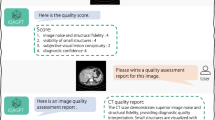Abstract
The emergence of Large Multimodal Models (LMMs) has unlocked remarkable potential in AI, particularly in pathology. However, the lack of specialized, high-quality benchmark impeded their development and precise evaluation. To address this, we introduce PathMMU, the largest and highest-quality expert validated pathology benchmark for LMMs. It comprises 33,428 multimodal multi-choice questions and 24,067 images from various sources, each accompanied by an explanation for the correct answer. The construction of PathMMU leverages GPT-4V’s advanced capabilities, utilizing over 30,000 image-caption pairs to enrich the descriptive quality of captions and generate corresponding Q&As in a cascading process. To maximize PathMMU’s authority, we invite seven pathologists to scrutinize each question under strict standards in PathMMU’s validation and test sets, while simultaneously setting an expert-level performance benchmark for PathMMU. We conduct extensive evaluations, including zero-shot assessments of 14 open-sourced and 4 closed-sourced LMMs and their robustness to image corruption. We also fine-tune representative LMMs to assess their adaptability to PathMMU. The empirical findings indicate that advanced LMMs struggle with the challenging PathMMU benchmark, with the top-performing LMM, GPT-4V, achieving only a 49.8% zero-shot performance, significantly lower than the 71.8% demonstrated by human pathologists. After fine-tuning, substantially smaller open-sourced LMMs can outperform GPT-4V but still fall short of the expertise shown by pathologists. We hope that the PathMMU will offer valuable insights and foster the development of more specialized, next-generation LMMs for pathology.
Access this chapter
Tax calculation will be finalised at checkout
Purchases are for personal use only
Similar content being viewed by others
References
Alayrac, J.B., et al.: Flamingo: a visual language model for few-shot learning. In: NeurIPS, pp. 23716–23736 (2022)
Aresta, G., et al.: Bach: grand challenge on breast cancer histology images. Med. Image Anal. 56, 122–139 (2019)
Arunachalam, H.B., et al.: Viable and necrotic tumor assessment from whole slide images of osteosarcoma using machine-learning and deep-learning models. PLoS ONE 14(4), e0210706 (2019)
Bai, J., et al.: Qwen-VL: a frontier large vision-language model with versatile abilities. arXiv preprint arXiv:2308.12966 (2023)
Bavishi, R., et al.: Introducing our multimodal models (2023). https://www.adept.ai/blog/fuyu-8b
Ben Abacha, A., Sarrouti, M., Demner-Fushman, D., Hasan, S.A., Müller, H.: Overview of the VQA-med task at ImageCLEF 2021: visual question answering and generation in the medical domain. In: Proceedings of the CLEF 2021 Conference and Labs of the Evaluation Forum-working notes (2021)
Borkowski, A.A., Bui, M.M., Thomas, L.B., Wilson, C.P., DeLand, L.A., Mastorides, S.M.: Lung and colon cancer histopathological image dataset (lc25000). arXiv preprint arXiv:1912.12142 (2019)
Brown, T., et al.: Language models are few-shot learners. In: NeurIPS, pp. 1877–1901 (2020)
Cai, R., et al.: BenchLMM: benchmarking cross-style visual capability of large multimodal models. arXiv preprint arXiv:2312.02896 (2023)
Chiang, W.L., et al.: Vicuna: an open-source chatbot impressing GPT-4 with 90%* ChatGPT quality (2023). https://lmsys.org/blog/2023-03-30-vicuna/
Dai, W., et al.: InstructBLIP: towards general-purpose vision-language models with instruction tuning. arXiv preprint arXiv:2305.06500 (2023)
Devlin, J., Chang, M.W., Lee, K., Toutanova, K.: Bert: pre-training of deep bidirectional transformers for language understanding. In: NAACL, pp. 4171–4186 (2019)
Driess, D., et al.: PaLM-E: an embodied multimodal language model. In: ICML, pp. 8469–8488 (2023)
Gamper, J., Rajpoot, N.: Multiple instance captioning: learning representations from histopathology textbooks and articles. In: Proceedings of the IEEE/CVF conference on computer vision and pattern recognition, pp. 16549–16559 (2021)
Gao, P., et al.: LLaMA-Adapter V2: parameter-efficient visual instruction model. arXiv preprint arXiv:2304.15010 (2023)
Gu, Y., et al.: Domain-specific language model pretraining for biomedical natural language processing. ACM Trans. Comput. Healthcare (HEALTH) 3(1), 1–23 (2021)
Guan, T., et al.: HallusionBench: an advanced diagnostic suite for entangled language hallucination and visual illusion in large vision-language models. In: CVPR, pp. 14375–14385 (2024)
Han, C., et al.: Wsss4luad: grand challenge on weakly-supervised tissue semantic segmentation for lung adenocarcinoma. arXiv preprint arXiv:2204.06455 (2022)
He, X., Zhang, Y., Mou, L., Xing, E., Xie, P.: Pathvqa: 30000+ questions for medical visual question answering. arXiv preprint arXiv:2003.10286 (2020)
Huang, Z., Bianchi, F., Yuksekgonul, M., Montine, T.J., Zou, J.: A visual-language foundation model for pathology image analysis using medical twitter. Nat. Med. 29(9), 2307–2316 (2023)
Ikezogwo, W., et al.: Quilt-1M: one million image-text pairs for histopathology. In: NeurIPS, pp. 37995–38017 (2023)
Kather, J.N., Halama, N., Marx, A.: 100,000 histological images of human colorectal cancer and healthy tissue. Zenodo10 5281 (2018)
Kriegsmann, K., et al.: Deep learning for the detection of anatomical tissue structures and neoplasms of the skin on scanned histopathological tissue sections. Front. Oncol. 12, 1022967 (2022)
Kumar, V., Abbas, A.K., Fausto, N., Aster, J.C.: Robbins and Cotran Pathologic Basis of Disease, Professional Edition E-book. Elsevier Health Sciences (2014)
Lau, J.J., Gayen, S., Ben Abacha, A., Demner-Fushman, D.: A dataset of clinically generated visual questions and answers about radiology images. Sci. Data 5(1), 1–10 (2018)
Li, B., Zhang, Y., Chen, L., Wang, J., Yang, J., Liu, Z.: Otter: a multi-modal model with in-context instruction tuning. arXiv preprint arXiv:2305.03726 (2023)
Li, B., Wang, R., Wang, G., Ge, Y., Ge, Y., Shan, Y.: SEED-Bench: benchmarking multimodal LLMs with generative comprehension. arXiv preprint arXiv:2307.16125 (2023)
Li, C., et al.: LLaVA-Med: training a large language-and-vision assistant for biomedicine in one day. In: NeurIPS, pp. 28541–28564 (2023)
Li, C., et al.: YOLOv6: a single-stage object detection framework for industrial applications. arXiv preprint arXiv:2209.02976 (2022)
Li, J., Li, D., Savarese, S., Hoi, S.: Blip-2: bootstrapping language-image pre-training with frozen image encoders and large language models. In: ICML, pp. 19730–19742 (2023)
Liu, H., Li, C., Wu, Q., Lee, Y.J.: Visual instruction tuning. In: NeurIPS, pp. 34892–34916 (2023)
Liu, Y., et al.: MMBench: is your multi-modal model an all-around player? arXiv preprint arXiv:2307.06281 (2023)
Liu, Z., Mao, H., Wu, C.Y., Feichtenhofer, C., Darrell, T., Xie, S.: A convnet for the 2020s. In: CVPR, pp. 11976–11986 (2022)
OpenAI: Introducing ChatGPT (2022). https://openai.com/blog/chatgpt
OpenAI: Gpt-4 technical report (2023)
OpenAI: Gpt-4v(ision) system card (2023). https://cdn.openai.com/papers/GPTV_System_Card.pdf
Peng, Z., Wang, W., Dong, L., Hao, Y., Huang, S., Ma, S., Wei, F.: Kosmos-2: grounding multimodal large language models to the world. arXiv preprint arXiv:2306.14824 (2023)
Radford, A., et al.: Learning transferable visual models from natural language supervision. In: ICML, pp. 8748–8763 (2021)
Raffel, C., et al.: Exploring the limits of transfer learning with a unified text-to-text transformer. J. Mach. Learn. Res. 21(1), 5485–5551 (2020)
Seyfioglu, M.S., Ikezogwo, W.O., Ghezloo, F., Krishna, R., Shapiro, L.: Quilt-llava: visual instruction tuning by extracting localized narratives from open-source histopathology videos. In: CVPR, pp. 13183–13192 (2024)
Silva-Rodríguez, J., Colomer, A., Sales, M.A., Molina, R., Naranjo, V.: Going deeper through the gleason scoring scale: an automatic end-to-end system for histology prostate grading and cribriform pattern detection. Comput. Methods Programs Biomed. 195, 105637 (2020)
Sun, Y., et al.: Ernie 3.0: large-scale knowledge enhanced pre-training for language understanding and generation. arXiv preprint arXiv:2107.02137 (2021)
Sun, Y., et al.: PathGen-1.6M: 1.6 million pathology image-text pairs generation through multi-agent collaboration (2024). https://arxiv.org/abs/2407.00203
Sun, Y., Zhu, C., Zhang, Y., Li, H., Chen, P., Yang, L.: Assessing the robustness of deep learning-assisted pathological image analysis under practical variables of imaging system. In: ICASSP, pp. 1–5 (2023). https://doi.org/10.1109/ICASSP49357.2023.10095887
Sun, Y., et al.: PathAsst: a generative foundation AI assistant towards artificial general intelligence of pathology. In: AAAI, pp. 5034–5042 (2024)
Team, G., et al.: Gemini: a family of highly capable multimodal models. arXiv preprint arXiv:2312.11805 (2023)
Touvron, H., et al.: LLaMA: Open and efficient foundation language models. arXiv preprint arXiv:2302.13971 (2023)
Veeling, B.S., Linmans, J., Winkens, J., Cohen, T., Welling, M.: Rotation equivariant CNNs for digital pathology. In: Frangi, A.F., Schnabel, J.A., Davatzikos, C., Alberola-López, C., Fichtinger, G. (eds.) MICCAI 2018. LNCS, vol. 11071, pp. 210–218. Springer, Cham (2018). https://doi.org/10.1007/978-3-030-00934-2_24
Wang, J., et al.: Evaluation and analysis of hallucination in large vision-language models. arXiv preprint arXiv:2308.15126 (2023)
Wang, W., et al.: CogVLM: visual expert for pretrained language models. arXiv preprint arXiv:2311.03079 (2023)
Wei, J., et al.: A Petri dish for histopathology image analysis. In: Tucker, A., Henriques Abreu, P., Cardoso, J., Pereira Rodrigues, P., Riaño, D. (eds.) AIME 2021. LNCS (LNAI), vol. 12721, pp. 11–24. Springer, Cham (2021). https://doi.org/10.1007/978-3-030-77211-6_2
Xu, P., et al.: LVLM-eHub: a comprehensive evaluation benchmark for large vision-language models. arXiv preprint arXiv:2306.09265 (2023)
Yin, Z., et al.: LAMM: language-assisted multi-modal instruction-tuning dataset, framework, and benchmark. In: NeurIPS, pp. 26650–26685 (2023)
Yu, W., et al.: MM-Vet: evaluating large multimodal models for integrated capabilities. arXiv preprint arXiv:2308.02490 (2023)
Yue, X., et al.: MMMU: a massive multi-discipline multimodal understanding and reasoning benchmark for expert AGI. In: CVPR, pp. 9556–9567 (2024)
Zhang, X., et al.: PMC-VQA: visual instruction tuning for medical visual question answering. arXiv preprint arXiv:2305.10415 (2023)
Zhang, Y., Sun, Y., Li, H., Zheng, S., Zhu, C., Yang, L.: Benchmarking the robustness of deep neural networks to common corruptions in digital pathology. In: MICCAI, pp. 242–252 (2022)
Zhang, Z., et al.: Pathologist-level interpretable whole-slide cancer diagnosis with deep learning. Nat. Mach. Intell. 1(5), 236–245 (2019)
Zheng, S., et al.: Benchmarking pathCLIP for pathology image analysis. J. Imaging Inform. Med. 1–17 (2024). https://doi.org/10.1007/s10278-024-01128-4
Zhu, C., et al.: Weakly supervised classification using multi-level instance-aware optimization on cervical cytologic image. In: 2022 IEEE 19th International Symposium on Biomedical Imaging (ISBI), pp. 1–5. IEEE (2022)
Zhu, D., Chen, J., Shen, X., Li, X., Elhoseiny, M.: MiniGPT-4: enhancing vision-language understanding with advanced large language models. arXiv preprint arXiv:2304.10592 (2023)
Acknowledgements
This study was partially supported by the National Natural Science Foundation of China (Grant No.92270108), Zhejiang Provincial Natural Science Foundation of China (Grant No.XHD23F0201), the Research Center for Industries of the Future (RCIF) at Westlake University, and the Westlake Education Foundation.
Author information
Authors and Affiliations
Corresponding authors
Editor information
Editors and Affiliations
1 Electronic supplementary material
Below is the link to the electronic supplementary material.
Rights and permissions
Copyright information
© 2025 The Author(s), under exclusive license to Springer Nature Switzerland AG
About this paper
Cite this paper
Sun, Y. et al. (2025). PathMMU: A Massive Multimodal Expert-Level Benchmark for Understanding and Reasoning in Pathology. In: Leonardis, A., Ricci, E., Roth, S., Russakovsky, O., Sattler, T., Varol, G. (eds) Computer Vision – ECCV 2024. ECCV 2024. Lecture Notes in Computer Science, vol 15120. Springer, Cham. https://doi.org/10.1007/978-3-031-73033-7_4
Download citation
DOI: https://doi.org/10.1007/978-3-031-73033-7_4
Published:
Publisher Name: Springer, Cham
Print ISBN: 978-3-031-73032-0
Online ISBN: 978-3-031-73033-7
eBook Packages: Computer ScienceComputer Science (R0)




